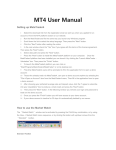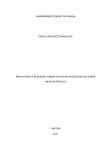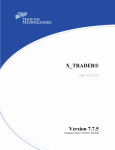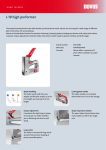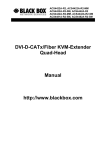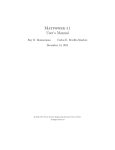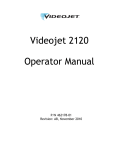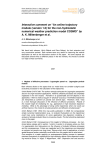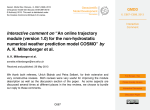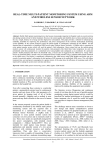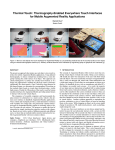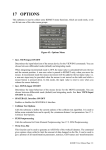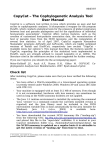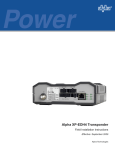Download A Geometrical Sketch Recognition System for UML Class
Transcript
Tahuti: A Geometrical Sketch Recognition System for UML Class Diagrams Tracy Hammond and Randall Davis AI Lab, MIT 200 Technology Square Cambridge, MA 02139 hammond, [email protected] Abstract We have created and tested Tahuti, a dual-view sketch recognition environment for class diagrams in UML. The system is based on a multi-layer recognition framework which recognizes multi-stroke objects by their geometrical properties allowing users the freedom to draw naturally as they would on paper rather than requiring the user to draw the objects in a pre-defined manner. Users can draw and edit while viewing either their original strokes or the interpreted version of their strokes engendering user-autonomy in sketching. The experiments showed that users preferred Tahuti to a paint program and to Rational RoseT M because it combined the ease of drawing found in a paint program with the ease of editing available in a UML editor. Introduction Sketching is a natural and integral part of software design. Software developers use sketching to aid in the brainstorming of ideas, visualizing programming organization and understanding of requirements. Unfortunately when it comes to coding the system, the drawings are left behind. Natural sketch recognition bridges that gap by allowing users to sketch as they would on paper, and since the sketch is recognized, allowing the sketch itself to take an active role in the coding process. Paper sketches offer users the freedom to sketch as they would naturally; for instance, users can draw objects with any number of strokes and strokes may be drawn in any order. However, because paper sketches are static and uninterpreted, they lack computer editing features, requiring users to completely erase and redraw an object to move it. Unified Modeling Language (UML) diagrams (Booch, Rumbaugh, & Jacobson 1998) are a de facto standard for depicting software applications. Within UML, class diagrams play a central role in describing program structure. Many of the symbols used in class diagrams are quite similar, and hence they offer an interesting challenge for sketch recognition. Traditional CASE (Computer Automated Software Engineering) tools, such as Rational RoseT M , give users powerful editing features, and even allow users to automatically generate skeleton user code. However, these CASE tools give the users very little if any flexibility to create a diagram. Users do not have the freedom to sketch their designs and are required to learn a large number of commands before they can use the system with ease. We have created Tahuti1 , a multi-stroke sketch recognition environment for class diagrams in UML where users can sketch the diagrams on a tablet or whiteboard in the same way they would on paper and the sketches are interpreted by the computer. Our system differs from graffiti-based approaches to this task in that it allows users to drawn an object as they would with pen and paper. The system recognizes objects based on their geometrical properties by examining the line segments’ angles, slopes, and other properties, rather than requiring the user to draw the objects in a pre-defined manner. Recognizing the objects by their geometrical properties gives users the freedom to sketch and edit diagrams as they would naturally, while maintaining a high level of recognition accuracy. In order to recognize the objects created from multiple strokes by their geometrical properties, we have created a multi-layer framework of recognition in which strokes are preprocessed, selected, recognized, and then identified. Upon recognition of an object the sketch recognition process most sketch recognition software replaces the users strokes with cleaned-up strokes that they did not draw. Some users are distracted by this process, preferring that their original strokes remain. Tahuti permits users to draw and edit, while viewing either their original strokes or the cleaned-up version of their strokes, thus engendering user-autonomy in sketching. The system is also non-modal: users can edit or draw without having to give any explicit command or mode change. To test the usability of Tahuti, we performed a field experiment in which subjects compared Tahuti to a paint program and to Rational Rose. Subjects created and edited a UML class diagram, using each method and quantifying the ease of drawing and editing of each method. 1 Tahuti, also known as Thoth, is the Egyptian god of wisdom. He always carried a pen and scrolls upon which he recorded all things. This paper is organized as follows. First, we review previous work on UML diagram sketch recognition. We then describe the multi-layer recognition framework used by the system and follow it with a discussion of the recognition algorithms used in the code and the multi-view interface. Next, we discuss the advantages of the Rational RoseT M interface. Finally, we present the results of our field experiment and offer directions for future research. Previous Work A Wizard of Oz experiment showed that users prefer a single-stroke sketch-based user interface to a mouseand-palette based tool for UML design (Hse et al. 1999). Users, though happy with the single-stroke version, requested more sketching flexibility, such as the ability to draw with multiple strokes. Ideogramic UMLT M (Damm, Hansen, & Thomsen 2000), a graffiti based diagramming tool, requires users to draw each single-stroke gesture in the style specified in the user manual. A consequence of the single stroke limit is that some of the gestures drawn only loosely resemble the output glyph. For example, ϕ is used to indicate an actor, drawn by the system as a stick figure. Edward Lank et al. built a UML recognition system that uses a distance metric (Lank, Thorley, & Chen 2000) which classifies strokes based on the total stroke length compared to the perimeter of its bounding box. This algorithm can cause many false positives. (For example, the letter M can be detected as a box.) Although the system does allow users to draw somewhat naturally, it does not allow users to edit naturally. Users don’t sketch edits to their diagrams, but rather use correction dialogue boxes. The domain of UML class diagrams is a node and link domain. Another system based on a node and link domain is Denim (Lin et al. 2001), which recognizes boxes and two link types to allow users to sketch and design web pages. However, in Denim, the link types are differentiated not by the geometrical properties of the drawn links, but rather by what the links connect. UML class diagrams are a subset of the software design domain. Other work has been done in the area of software design sketch recognition. Eric Lecolinet (Lecolinet 1998) has created a system to design GUIs based on modal interaction where the user is required to select an appropriate drawing tool. His system is quite different from the system that we are designing in that it does not allow free hand drawing and thus does not perform sketch recognition, but it does display an interesting use of sketch gestures. Landay (Landay & Myers 1995) has created SILK a tool that allows users to sketch interactive user interfaces. SILK was one of the first systems that recognized a sketch and allowed interactive use of the sketch without replacing the strokes with cleaned-up strokes and allowing the user to view and modify her originally drawn strokes. SILK and many other systems were based on the Rubine (Rubine 1991) recognition engine. The Rubine recognition engine recognizes objects statistically with the use of a linear discriminator, which processes a single stroke and determines certain features of it. The Rubine system does not break down the stroke into line segments or curves which prevents the creation of a hierarchical multi-stroke system of recognition. Bimber, Encarnacao, and Stork created a multilayer architecture for sketch recognition (Bimber, Encarnacao, & Stork 2000) of three-dimensional sketches. Their system recognizes objects created by multiple strokes with the use of a simple BNF-grammar to define the sketch language. However, due to the nature of their domain, the system requires users to learn drawing commands before using the system rather than giving users the freedom to draw as they would naturally. Multi-Layer Framework for Sketch Recognition Our system uses a multi-layer framework for sketch recognition. The multi-layer framework allows the system to recognize multi-stroke objects by their geometrical properties. The stages of the multi-layer recognition framework are: 1) Preprocessing 2) Selection 3) Recognition 4) Identification. After each stroke is drawn, rudimentary processing is performed on the stroke, reducing the stroke to an ellipse or a series of line and curve segments. A collection of spatially and temporally close strokes is chosen, and the line segments contained in the collection of strokes are then recognized as either an editing command or a viewable object. Figure 1 shows the stages of the multi-layer recognition framework applied to a drawn UML aggregation association. Stage 1: Preprocessing At the most basic level, strokes drawn by the user are processed using algorithms for stroke processing developed in our group (Sezgin, Stahovich, & Davis 2001). The preprocessing stage uses stroke timing data to find possible corners as users tend to slow down while drawing a corner. A stroke is processed only once, immediately after having been drawn. The stroke is fit to each of the following 1) an ellipse, 2) a line, 3) a polyline, which is a collection of line segments, and 4) a complex shape, which is a collection of line segments and bezier curves. Along with the original data points, the stroke data structure contains each possible interpretation and its probability of correctness. Figure 1a shows us the originally drawn strokes of a UML aggregation association. The diamond-headed arrow was drawn using two strokes. The stroke is processed immediately after it is drawn. The data structure of the strokes will contain a fit for a best fit ellipse, line, polyline, and complex shape. In Figure 1b we see the polyline interpretation of the strokes. last nine unrecognized strokes can possibly be included in a stroke collection. All recognizable objects within the UML class diagram domain are connected objects. Thus we require all strokes within a collection to be within close proximity of other strokes in the collection. Let C be the collection of all of the strokes. Let S be a subset of the strokes. For every subset S, where S is nonempty and C − S is nonempty, we require that the smallest distance between the subsets be less than a threshold τ . (SubsetDistance(S, C −S) < τ ) Experimentally, we set τ to be 10 pixels. [ [ j=1..m D(Xi , Yj )) SubsetDistance(X, Y ) = M in( i=1..n Figure 1: Multi-layer framework of recognition used in Tahuti: A UML aggregation association is identified using the multi-layer recognition framework. a) The association was originally drawn using two strokes. b) During the preprocessing stage, the original strokes are processed into line segments. c) The two strokes of the arrow are then selected for recognition. d) Recognition occurs on the two strokes, at which point a UML aggregation association is deemed as a possible interpretation. e) The collection of strokes is identified as a UML aggregation association. (1) In the above equation, n and m are the number of line segments in X and Y respectively and Xi represents the ith line segment. D is the distance function computing the distance between two points. In Figure 1c we see the two strokes of the UML aggregation association selected. Note that this is not the only collection that would have been created. Assuming that the arrow shaft was drawn first, after the arrow shaft was drawn, a stroke collection would have been formed with only that stroke. Another stroke collection would have been formed with only the stroke of the arrow head. If other unrecognized strokes are present in the diagram, several more stroke collections including these strokes would be created for recognition testing. After all stroke collections have been created, the recognition stage attempts to recognize the stroke collections as possible viewable objects or editing commands. Stage 2: Selection Stage 3: Recognition After the recently drawn stroke has been preprocessed, the stroke is combined with zero or more unrecognized strokes to form a collection of strokes. This collection of strokes is then sent to the recognizer where it checks if the combined strokes form a recognizable object or editing command. Ideally, all possible stroke combinations would be tested for possible recognition of a recognizable object or editing command. However, if we allow the system to test for all possible stroke combinations, it would take exponential time based on the number of strokes to identify an object. While this is okay for small diagrams, this would be unacceptable for large diagrams, making the system unusable. To reduce the number of stroke collections for recognition, we use spatial and temporal rules to prune off stroke collections. To ensure that all interactions take polynomial time based on the number of strokes, we limit the number of strokes in a collection to a threshold. Experimentally, we have found that 9 strokes is an acceptable threshold. Since users tend to draw an entire object at one time, finishing to draw one object before drawing the next, it is generally safe to form stroke collections consisting only of strokes drawn recently. Thus, only the During the recognition stage, all stroke collections are examined to see if a particular stroke collection could be interpreted as a viewable object or an editing command. An editing command is a collection of strokes indicating deletion or movement of a viewable object. The system currently recognizes eight viewable objects: a general class, an interface class, an inheritance association, an aggregation association, a dependency association, an interface association, text, or a collection of unrecognized strokes. The algorithms used in the recognition stage will be described in more detail in the next section. If more than one interpretation is possible for any stroke collection, the final interpretation is deferred until the identification stage. In Figure 1e we see that the arrow recognition algorithm accepted the two selected strokes as a UML aggregation association. Other stroke collections presented to the recognition stage also have interpretations. For example, the collection of strokes consisting only of the arrow head stroke is recognizable as a general class since it forms a square-like shape. The decision between choosing the general class interpretation and the UML aggregation association is deferred until the identification stage. Stage 4: Identification During the identification stage, a final interpretation is chosen, and a collection of strokes is identified as a viewable object or an editing command. All possible interpretations found in the recognition stage from the stroke collections are presented to the identification stage. The identification stage selects the final interpretation based on the following rules. Object Movement An interpretation of object movement has priority over any other possible interpretation. Object movement recognition is interesting in that it is the only interpretation that can be decided on while the stroke is still being drawn. If object movement is recognized, the multi-layer recognition framework will be short-circuited, preventing the stroke to be recognized by other algorithms. Immediate recognition is necessary for movement to allow the user to visually move the objects in real time, rather than having the object move only after the stroke is completed. Any Interpretation Any interpretation is preferred to no interpretation, where no interpretation leaves the stroke collection as a collection of unrecognized strokes. Many Strokes We prefer to recognize collections with a larger number of strokes since our goal is to recognize as much of what the user draws as possible. Correctness Probability Each algorithm has a ranking based on its probability of correctness. The probability of correctness is a combination of both prior and predicted probability. Certain recognizers have a higher level of accuracy than others, giving a prior correctness probability. Predicted probability is calculated during recognition, for example, the ellipse fit predicted probability of correctness is much higher for a perfectly drawn ellipse than a crooked ellipse. If more than one interpretation is still possible, the interpretation with the highest ranking is then chosen. After the final interpretation is chosen, the associations are examined to see if any unconnected associations can be connected to a class. This is done by checking if an association endpoint lies on or near a general or interface class. Recognition Stage Algorithms Figure 2: Rectangle Recognition Process. a)The line segments of the polyline fit of the strokes. b) The endpoints of the line segments from a) are specified. c) The endpoints of one line segment have been labelled. d) The endpoints of two line segments have been labelled. e) All line segments have been labelled. f) The new line segments after the joining. parallel to the horizontal plane or that it be created from a single stroke or even one stroke per side. The algorithms inputs are the lines segments of the polyline fit of the preprocessed strokes. (See Figure 2a-b.) The six steps are: 1. Confirm that the preprocessed collection of strokes consist of at least 4 line segments of non-trivial size (> 10 pixels). 2. Order the lines into a circular path by numbering the endpoints one by one: (a) Select a line segment to start. Label it’s first endpoint 0. Label its other endpoint 1. (See Figure 2c.) (b) Find the closest unlabelled endpoint to the last labelled endpoint n. Label it n + 1 and the other endpoint of the segment n + 2. (See Figure 2d-e.) (c) Repeat above until all endpoints are labelled. 3. Confirm that first endpoint labelled is relatively close to the last endpoint labelled (i.e., that the distance is < 1/4 of the distance between the two points furthest apart.) During the recognition stage of the multi-layer recognition framework, stroke collections are tested for possible interpretations. In particular, we present here the recognition algorithms for rectangle, ellipse, arrow, and editing action recognition. 4. Join lines that have adjacent endpoints with a similar slope. (See Figure 2f) Rectangle Recognition The above algorithm recognizes rectangles containing any number of strokes. The strokes can be drawn in any order, and the strokes can stop or start anywhere on the side of the rectangle. The algorithm emphasizes that the rectangle be recognized by its geometrical properties General classes are represented as rectangles in UML class diagrams. To recognize rectangles we constructed an algorithm based on a rectangle’s geometrical properties. The algorithm does not require that the class be 5. Confirm that there are four lines left. 6. Confirm that every other line is parallel and that adjacent lines are perpendicular. rather than the method in which it was drawn. This method allows users to draw as they would naturally without sacrificing the recognition accuracy. Ellipse Recognition Interface classes are represented as ellipses in UML class diagrams. After a stroke has been preprocessed, if the ellipse fit has the highest probability compared to the complex shape, polyline, or line fit, the interface class recognition algorithm accepts the stroke as an interface. The algorithm accepts only a single stroke in the collection of strokes because the ellipse recognizer created by (Sezgin, Stahovich, & Davis 2001) is only a single stroke recognizer since it depends on the time and speed data of the stroke. To recognize multi-stroke ellipses, we could assemble two curves together in a process similar to the rectangle recognizer, but in practice this has not been necessary. The single stroke requirement for the interface class is not a hindrance to the user since circles are almost always drawn with a single stroke. Arrow Recognition We present here two methods for arrow recognition, geometrical and contextual. The geometrical method is used if the user has drawn an arrow complete with an arrow head to specify the association type. The contextual method is used if the user has only drawn the arrow shaft connecting two classes, letting the application assume the dependency association. Geometrical Method for Arrow Recognition Associations are represented by arrows in UML of which there exist three types: aggregation association with a diamond arrow head, inheritance association with a triangular arrow head, and dependency association with an open arrow head (See Figure 3. The recognition algorithm uses the polyline fit of the preprocessed strokes. To facilitate recognition of all three types, we identified five feature points (A, B, C, D, E) as labelled in Figure 1d and Figure 3. 1. Locate the arrow shaft by locating the two points furthest from each other (points A and B). 2. Locate the arrow head ends by locating points furthest from arrow shaft on either side (points C and D). 3. Let point E be the point on line AB that is twice the distance from B as the intersection point of lines CD and AB. 4. Classify each of the line segments as part of the arrow shaft, an arrow head section, or unclassified (AB, BC, BD, CD, CE, DE, or unclassified) based on the line’s bounding box, slope, and y-intercept. 5. Compute the total length of each of the line segments in each section (AB, BC, BD, CD, CE, DE, or unclassified). A section is said to be filled if the total length of each of the line segments in each section is greater than half the ideal length of the segment. Figure 3: Points A, B, C, D, and E as determined in the arrow recognition algorithm 6. Confirm sections AB, BC, and BD are filled. 7. Confirm that the unclassified section accounts for less than 1/4 of the total strokes length. 8. Based on the results of the line-segment classification, classify the arrow type as follows: (a) open head: CD, CE, and DE not filled (b) diamond head: CE and DE filled (c) diamond head: CD not filled and either CE or DE filled (d) triangular head: Either CE or DE not filled and CD filled Contextual Method for Arrow Recognition Contextual information can be used to recognize arrows. If a stroke without a specified arrow head starts in one class and ends in another, the stroke is interpreted as an arrow. The stroke is assumed to be a dependency relationship with the first class being dependent on the second if both classes are general classes. In this case the dependency arrow head is added to the interpreted diagram. If one class is an interface class, the interpreted diagram replaces the stroke with a straight line connecting the two classes creating an interface association. The association is attached to the classes and will move in accordance with the classes if the class is moved. Deletion Recognition Deletion is indicated by scribbling over an object. We define class deletion lines to be the horizontal, vertical and diagonal lines passing through the body of a class. Deletion of an interface or general class is recognized by checking if the stroke collection crosses a deletion line of the class more than four times. Deletion of a relationship is recognized by checking if the collection of strokes crosses the arrow more than four times. More than one object can be deleted with a single deletion command. Movement Recognition A stroke is recognized as a movement action if the user has clicked and held the cursor over the body of a class or the endpoint of an association with relatively little movement for a period of time greater than a half second. After the stroke is identified as a movement action, the cursor changes to a gripping hand and any further Figure 4: Interpreted UML class diagram Figure 6: Diagram of Figure 4 with the classes moved, Figure 5: Drawn view of Figure 4 Figure 7: Drawn view of Figure 6 movement of the cursor will move the object appropriately. Recognition of a stroke as movement of an object must occur during the stroke, rather than after the stroke is completed. In this case, the recognition process is short-circuited and no other interpretations are attempted. If an interface or general class is moved, any relationships attached to the class will remain attached moving in rubber-band format. If a relationship is moved, the endpoint moved will detach from any class it is currently attached to. Once the relationship is moved and the mouse released, the relationship endpoint is examined to see if it should be reattached to a class or remain unattached. It is possible for a relationship type to change from an aggregation, inheritance, or dependency relationship to an interface relationship if the arrow is moved from a general class to an interface class, or vice versa. we can see that the identified text describing the ObjectRendered class remains attached to the correct class when the class is moved. In future work, we intend to perform character recognition on the text. Although we currently do not recognize text, class, property, and method names can be named using a form. Text can be input into the form using the panel keyboard and a mouse or by typing directly with the keyboard. Figure 8 shows a picture of the form inputting information for the Game class. Notice that the information on the form is also updated on the diagram. Text Text can be handwritten directly onto the class. In Figures 4-7, the ObjectRendered class contains the text desciption ”graphics”. Note the the text is not recognized, but merely identified as text. It is identified using a combination of properties such as size and location. The text must be small in comparison to the class size. The text must lie inside of or near a class. In Figures 4-7 Multi-View System While sketching, the user can seamlessly switch between two views: the drawn view (Figure 7) which displays the users original strokes or the interpreted view (Figure 4) which displays the identified objects. Users can draw and edit in either view. Editing commands operate identically in the two views, with the drawn view allowing users to view and edit their original strokes. When a class is dragged, the strokes of an attached association must be stretched, translated, and rotated in order for it to remain attached and the strokes faithful to those originally drawn. Figure 6 shows the results after moving classes in Figure 4. The drawn view is shown in Figure 7. The strokes shown in the drawn view are not the same Figure 9: Rational Rose diagram of Figure 4 Figure 8: Class names, property names, and method names can be input into the form using the panel keyboard and a mouse or by typing directly with the keyboard. as those shown in the interpreted view. Several complications arise from this. One such complication is that we now have to keep track of three different sets of stroke data for each stroke drawn. Thus for each viewable object, the data structure must contain 1) the original strokes, 2) the uninterpreted strokes (the strokes viewable in the drawn view), and 3) the interpreted strokes (the strokes viewable in the interpreted view). The uninterpreted strokes are not the same as originally drawn strokes since the object may have been moved, causing the viewable strokes to have been stretched, translated, or rotated. After movement of an object, the uninterpreted strokes are recalculated based on the original strokes rather than the current uninterpreted strokes to ensure no loss of accuracy. Since the originally drawn strokes and the viewable strokes in the interpreted view are different, the recognition algorithms must take into account the current view. For example, when deleting an association in the interpreted view, the line or arrow shaft representing the relationship must be crossed. However, in the drawn view, the stretched, scaled, or rotated original strokes representing the relationship must be crossed. Rational RoseT M Diagrams and Code Generation Since Tahuti has recognized the UML diagram, it can generate Rational RoseT M diagrams, providing additional benefits to the user. Rational Rose is popular in industry as it offers a wide number of powerful features such as the ability to create a UML diagram from code and automatic code generation. Figure 9 displays the Rational RoseT M diagram generated from the diagram in Figure 4. Rational Rose can generate base Java code for each of the interface and general classes in the UML class Figure 10: Code automatically generated by Rational RoseT M for Deck and Hand class. diagram. Class names entered using the form in Figure 8 will appear in the automatically generated Rational RoseT M diagram and the automatically generated Java code. Figure 10 displays the automatically generated code of two classes. Notice that the Hand class extends the Deck class and that the Deck class implements the Dealable interface, as specified in the original sketch. Experiment In a preliminary study, six subjects were asked to draw and edit a UML diagram in four different ways: A) using a paint program, B) using Rational RoseT M C) using Tahuti in interpreted view D) using Tahuti in drawn view. Subjects were aided in the use of Rational Rose if they were unfamiliar with it, but little instruction was given otherwise. The subjects were asked to rank the four methods on a continuous scale from zero to five (with zero being the hardest and five being the easiest) both for ease of drawing and for ease of editing. Figure 11 displays the results for ease of drawing. Figure 12 displays the results for ease of editing. The results display that subjects greatly preferred the interpreted sketch interface of Tahuti. At the end of the study, a brief interview was held with each subject. During this time, the subjects stated that they appreciated having the freedom to draw as they would on paper along with the editing intelligence of a computer application. Subjects said that editing was difficult in the paint program because of the large amount of re-sketching required for class movement. Conclusion Figure 11: Results of user study for ease of drawing. Note that users preferred drawing in the interpreted view of Tahuti. We have created and tested Tahuti, a dual-view, multistroke sketch recognition environment for class diagrams in UML. Tahuti combines the sketching freedom provided by paper sketches and the processing power available in an interpreted diagram. The system is based on a multi-layer recognition framework and recognizes objects by their geometrical properties, rather than requiring that the user draw the objects in a pre-defined manner. By recognizing objects by their geometrical properties, Tahuti allows users to sketch as they would naturally without sacrificing the recognition accuracy. The experiments showed that users preferred Tahuti to a paint program and to Rational RoseT M because it combined the ease of drawing found in a paint program with the ease of editing available in a UML editor. Acknowledgements This work is supported in part by the Ford/MIT Alliance and the MIT Oxygen Collaboration. The authors appreciate the help of Louis-Philippe Morency, Michael Oltmans, and Raghavan Parthasarthy in reviewing this paper. References Figure 12: Results of user study for ease of editing. Note that users preferred editing in the interpreted view of Tahuti. Subjects complained that Rational Rose was extremely nonintuitive and that they had difficulty performing the commands they wished to perform. Most subjects preferred to work in the interpreted view rather than the drawn view. The subjects contrasted the domain of UML class diagrams with domains such as Mechanical Engineering and Architecture where a cleaned-up drawing may imply a finished design. They stated that the domain of UML class diagrams is one where cleaned-up drawings are appreciated since the drawings are created in the design stage and cleaned-up drawings do not imply solidified ideas. The subjects said that they would prefer to work in the drawn view in a domain such as Mechanical Engineering and Architecture. The subjects predicted that the drawn view would be a valuable feature in any domain to allow them to examine their original strokes when necessary. Our experiment suggests that future system enhancements should consider incorporating an ability to recognize multiplicity relationships and modification of recognized objects, (e.g., changing a dependency association into an inheritance association by adding a stroke). Further field evidence is, however, necessary before any categorical recommendations can be made in this area. Toward this end, future research should test Tahuti, using larger samples, tighter controls, and varied experimental setting. Bimber, O.; Encarnacao, L. M.; and Stork, A. 2000. A multi-layered architecture for sketch-based interaction within virtual environments. In Computers and Graphics, volume 24, 851–867. Booch, G.; Rumbaugh, J.; and Jacobson, I. 1998. The Unified Modeling Language User Guide. Reading, MA: Addison-Wesley. Damm, C. H.; Hansen, K. M.; and Thomsen, M. 2000. Tool support for cooperative object-oriented design: Gesture based modeling on an electronic whiteboard. In CHI 2000. CHI. Hse, H.; Shilman, M.; Newton, A. R.; and Landay, J. 1999. Sketch-based user interfaces for collaborative objectoriented modeling. Berkley CS260 Class Project. Landay, J. A., and Myers, B. A. 1995. Interactive sketching for the early stages of user interface design. In CHI, 43–50. Lank, E.; Thorley, J. S.; and Chen, S. J.-S. 2000. An interactive system for recognizing hand drawn UML diagrams. In Proceedings for CASCON 2000. Lecolinet, E. 1998. Designing guis by sketch drawing and visual programming. In Proceedings of the International Conference on Advanced Visual Interfaces (AVI 1998)., 274–276. AVI. Lin, J.; Newman, M. W.; Hong, J. I.; and Landay, J. A. 2001. Denim: An informal tool for early stage web site design. In Video poster in Extended Abstracts of Human Factors in Computing Systems: CHI 2001, pp. 205–206. Rubine, D. 1991. Specifying gestures by example. In Computer Graphics, volume 25(4), 329–337. Sezgin, T. M.; Stahovich, T.; and Davis, R. 2001. Sketch based interfaces: Early processing for sketch understanding. In The Proceedings of 2001 Perceptive User Interfaces Workshop (PUI’01).








